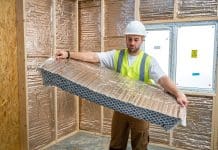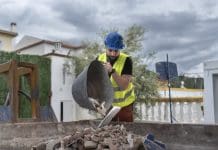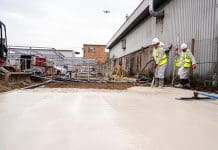David Simpson MRTPI, Planning Advisor for the Alliance for Sustainable Building Products (ASBP) examines the RE-Fab approach and its potential to allow for the sustainable deconstruction and re-deployment of buildings or their components…
RE-Fab was officially launched at Resource on 4th March 2015. The name RE-Fab is derived from the term ‘resource efficient fabrication’, an idea conceived by the Alliance for Sustainable Building Products (ASBP) and Ecobond Cymru, the aim of which is to facilitate the delivery of permanent quality buildings that can be deconstructed and either re-deployed as a complete building or as components that can be re-deployed in new buildings.
The approach of RE-Fab is to drive the move towards a more circular approach to construction through the development of sector specific business models for delivery into education, health, military, retail, offices and housing through the use of procurement frameworks.
As its name implies, the RE-Fab concept would involve a more flexible approach to building development as needs and demands change over time, as opposed to the traditional process of delivering a permanent facility of a defined lifespan after which the structure is largely demolished with only limited scope for component re-use and consequent wastage of material and the labour involved in its initial construction. The RE-Fab approach would therefore also require more flexibility in statutory regulations and their application, such as town planning and building control.
This raises a number of fundamental issues for the development process. The current town planning system has to some extent evolved over time in response to changing market conditions insofar as it is now possible to change and adapt the specific use of a building within certain parameters without the need to apply or re-apply for planning permission. For example, some commercial uses within retail areas and high streets can, subject to certain restrictions, be changed between different types of use – shops, banks or building societies, food and leisure uses – where occupancy changes or the premises become redundant. It is also possible, as most householders will know, to add to or extend dwellings and other buildings subject to certain conditions and size restrictions, without the need to apply for planning permission, where these fall within ‘permitted development’. Such amendments to the control regime have on the whole increased efficiency and market responsiveness without undermining the equally important function of protecting the environment and interests of other occupants and the community.
Apart from such cases, however, on the whole, planning permission for most types of building must be made for a specific type, size and design firmly defined on a set of scaled drawings showing the development exactly located in relation to its surroundings and adjacent development. Apart from very minor variations to such drawings once approved, any changes must be the subject of a further application and consequent local debate.
As part of the development of the RE-Fab approach, we intend to explore with the relevant government departments, professional bodies and other interested parties, whether the current systems of planning and building control could be made more flexible and responsive to the RE-Fab approach in order to allow for re-use and reconfiguration of building elements over time without the need to always have to reapply for permission.
For example, let’s suppose a school or other institutional building required more space for a specific activity – say an additional classroom block or lecture hall – but that the need for this space might not prove to be permanent. Ideally, it should be possible for the occupants to reconfigure the layout at some point in the future to enable the space to be recreated on another part of the site or development. This could be provided for in the initial approval by defining, say, certain zones within the overall site, which could accommodate the approved structure(s) where these would not materially affect adjoining occupants beyond the impacts initially considered when permission was granted.
Another potential solution might be to explore whether the current concept of an ‘outline’ planning permission with full details of siting , design, means of access and other matters reserved for subsequent approval could be extended to allow more flexibility and/or time limits within which such matters could be considered or re-submitted.
Alternatively, it might be possible to extend the concept of ‘permitted development’ as applied to householders and other small scale structures, to cover certain increases or variations in the size of other types of building. The local planning authorities and statutory agencies would of course need to be satisfied that any additional flexibility did not undermine the ability and duties of the planning system to safeguard the built environment, amenity and interests of the local community and it will be important to ensure that any recommended amendments to the current system of controls achieves this.
There will no doubt be other potential solutions for achieving such flexibility and these will need to be carefully considered and debated over the coming months. We believe however that the potential benefits of the RE-Fab approach in terms of sustainability, carbon reduction in construction and resulting ability to secure the efficient re-use of building components make the effort well worthwhile. Sustainability and sustainable development are now central to the planning and development process and RE-Fab represents a means of extending and developing this approach even further.
David Simpson MRTPI
Planning Advisor
Alliance for Sustainable Building Products (ASBP)
Tel: 020 7704 3501














All properties under refurbishment should be treated as new builds and Fire safety should be paramount at the planning stage. With any risk elements dealt with accordingly